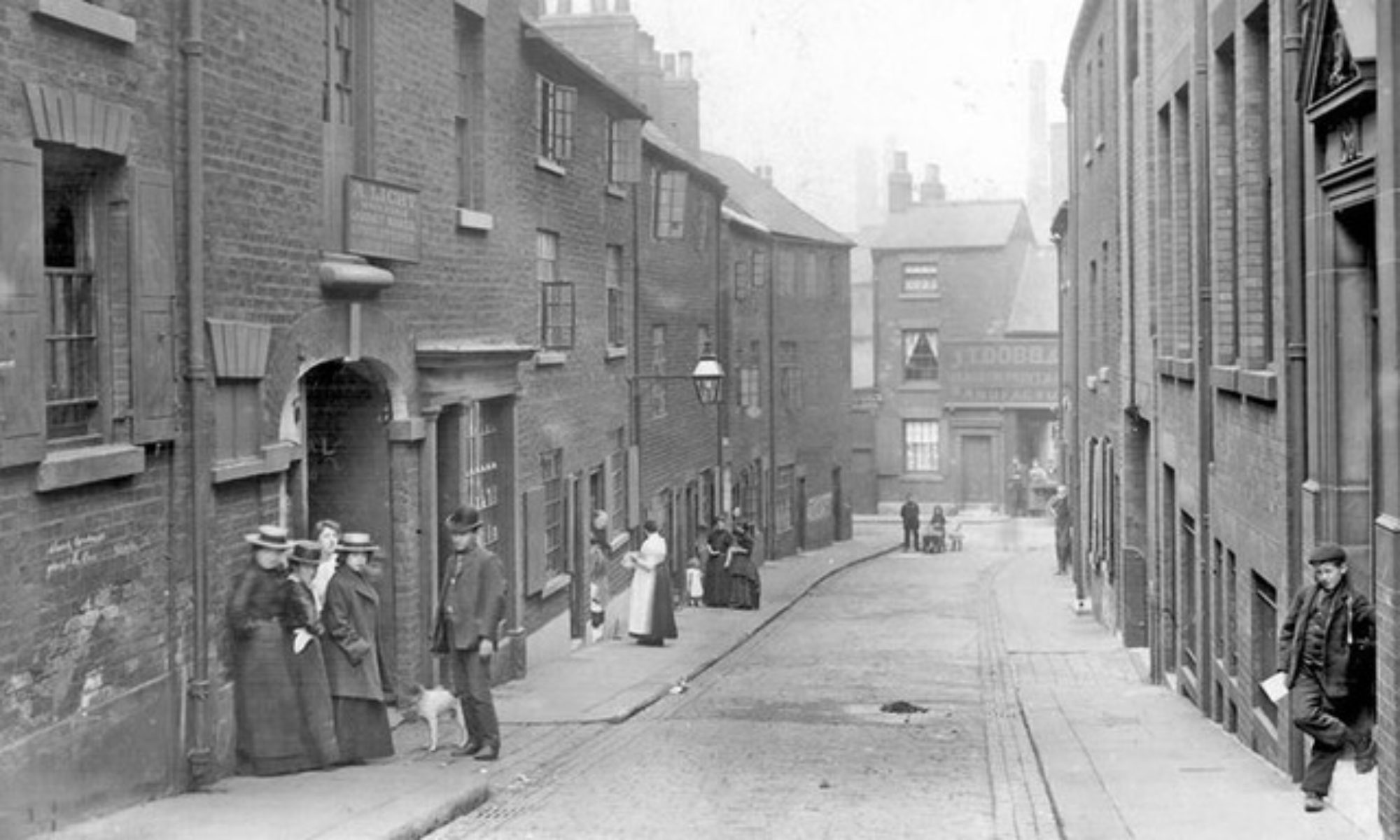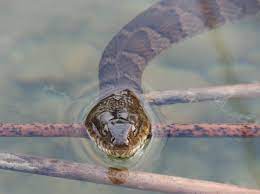EPISODE 554 PART 5 AUGUST 9 TO AUGUST 21, 1958 WORST JOB I EVER HAD IN MY LIFE
alan skeoch March 17, 2022
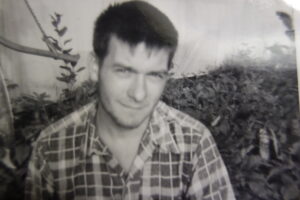
I think this picture captures how miserable our job became. What the picture misses is the thrill of being alone in a real wilderness.
NOTE: My pictures are not great as all I had was a little Kodak Brownie that leaked light. Pics are sure authentic however. Without the pics you might think the whole ordeal was a construct of my mind. Believe it or not my former boss, Norman Paterson…”Doctor Norman Paterson”…the man who sent me on this secret mission. Well he just sent me a picture of his early days in mining exploration where he is using a scrub board and pail of water to wash his clothes. We did not have the luxury of a scrub board. As I read my Diary the memories flood back. Regrets? Not one. This was a rite of passage into adulthood. Adversity could be handled.

> > > > Pilot delivering mail and taking Floyd out of the bush to a new job in Michigan. Imagine the shock we felt when our lead man, Flory Faulkner, was suddenly flown out leaving Bob, Walt and I to suddenly take over the project. We still had “miles to go before we sleep”, as poet Robert Frost wrote. > 
> > NOTE: There were other surprises on August 8. Our black bear had paid a visit to the Base Camp. Somehow he managed to climb the tree where our meat cache was stored. Or maybe he just lowered the rope. > Our 20 pound cooked ham was gone.
> How did the bear do it? > 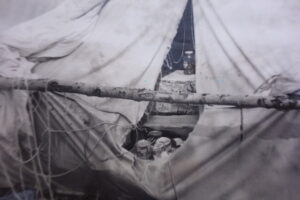
> > > The bear also ripped this hole in our cook tent and then rummaged around for food. He did not pop open the canned goods thankfully. > Why did he not use the front door flap? Some cans were bent but his teeth did not cut the can open. I suppose the bear damage could have been worse it it was a female bear with a bunch of cubs. Tracks indicated single bear.
> August 9, 1958 > > Bob Hilkar spent the day reorganizing our targets while waiting for a new > man to be flown in from South Porcupine. This gave us a chance to do our washing…clothes and bodies. We were all covered with > layer after layer of fly repellent along with smoke from our cook fires. The dirt is not all bad since it seems to make us less appealing to > the flies…moose flies, deer flies, mosquitoes, black flies, sand flies, ground wasps, blow flies. Why list them again? Because their presence is a constant reminder of how miserable our life had become. > > But good things happen. What a great day. We gorged ourselves on the fresh food knowing it would not last once the bear and the blow flies got wind of it. > So we had steaks, fresh vegetables, some bananas and one whole watermelon. > > The bear must have been watching close by on the opposite river bank. There he stood for a moment like a big black rock. > I got a shot of him with my camera but he was too far away and > too quick to clear out. > > August 10, 1958 >

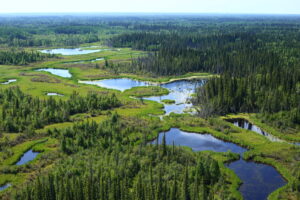
This picture gives some idea of the difficulties we faced in these boreal forest wetlands. Very charming from the vantage of an airplane seat…but a nightmare to cross in a straight line. Ronka E.M. unit surveys relied upon a scientific grid so that any anomaly could be mapped. Which meant obstructions had to be overcome. Pick a straight line through this swampland and then think of your poor feet. A;; that nice green stuff is spongy moss…bloody difficult to walk on. The larger green patches are tag alder bushes….the kind that Robert Hopkins sliced himself on the bounce back of his blazing axe. We really found open spots as big as this. All the same most of our work in 1958 involved swampy wetlands with windfalls. 
> We packed the canoe and headed downstream…i.e. north, for the Groundhog River flows north to James Bay which is part of > the huge Hudson’s Bay watershed. “Another swamp camp, boys, pack lightly.” We cut line eastward from the river for half a mile > where we struck a trap line and decided to follow it in the desperate hope we would reach the new anomaly without the work of > blazing. But we were disappointed for the trappers trail began to angle north rather than east. > > This must be the trapper who left his traps open for some reason when he took his first out in the spring. Or he had died. We were > constantly finding open traps on the creeks and beaver dams. Some had the skeletons of dead animals and a couple had > been recently snapped shut on the legs of a mink and a muskrat. Why do this unnecessary killing? Leg hold traps are really > inhumane for they hold the animal in great distress. Some animals chew their own legs off to make an escape. >
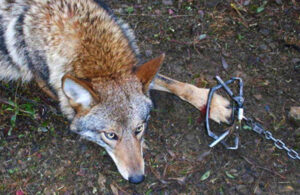

> We retraced out steps and went back to base camp #1 resolved to try to reach the eastern anomaly again tomorrow…this time > blazing a trail as we packed in. No easy task to blaze while carrying everything needed in huge packs. > > As we returned up river we noticed something large and white on the river shore. It was a large moose head complete with > a perfect set of antlers. “You want it, Al?” “Sure do.” So we wedged the thing in the canoe and I planned to get it back to Toronto > one way or another. > > Distance covered: 16,000 feet (mostly wasted) > 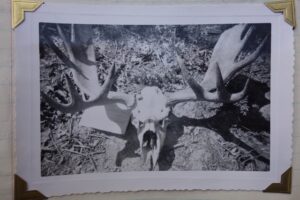
> > > My trophy from the Groundhog River job…a moose head found on the banks of the Groundhog River. > 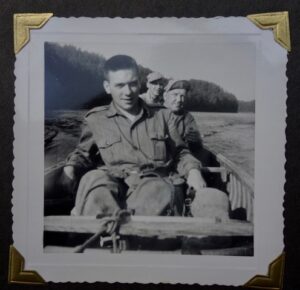
> > > Photo was taken earlier in summer because my hair is short and no beard. But picture makes point that Walter and Bob and me are now > a three man crew after Floyd was taken from us. We needed a fourth man and got Robert Hopkins on a return flight. > 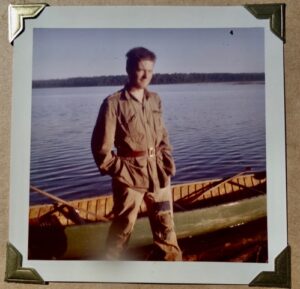
> > > By midsummer, I was a darn sight thinner. > > August 11, 1958 > > Walt and I were sent upstream (southwards in other words) about a mile and half with orders to extend > the trail we had cut back on July 24. Almost immediately this became extremely difficult a we hit an alder swamp about 800 feet wide > with water at various depths. Alder shrubs are very difficult to slash on dry land as they are thin and > elastic like. A swipe with a blazing axe does nothing unless the cut is aimed close to the ground. And when severed the decapitated > alder remain as a giant spike capable of penetrating our gum rubber boots. In this swamp cutting was super difficult as > the alder roots were under the water. Swinging an axe for an underwater cut is just about impossible. To make matters worse > in the centre of the swamp was open water…a large stream. So we had to build another bridge. >


> As if these problems were not big enough, we came across a number of water snakes of various length. > > While returning to camp we startled up another bull moose. More moose in here than people., >


> Distance travelled: 16,000 feet > > August 12, 1958 > > Stormy weather until late afternoon when sky cleared and Austin Airways sent in the Beaver with our new man, Robert Hopkins. > First bush job for him…he is about my age…hope he can handle a blazing axe. > > August 13, 1958 > > We packed food supplies and placed them in a cache using trail cut on August 10. Then we extended the trail for a mile and a half. > Robert Hopkins is nice enough but has never handled an axe before and keeps swinging at thin branches. Axe bounces back…very > dangerous. “Hit where the branch joins the tree.” Wish he would do this as his actions are dangerous. > > The swamp apples are ripe…big orange berries on a small ground plant in the swamps. Sweet taste…too sweet really. > > Water on the river is low again so many areas have rapids. We got caught in a cross eddy which turned us broadside to > the river flow and then jammed us on the rocks. The canoe did not overturn as we pushed and pulled it back from the > rocks and shot down a kind of chute. Only damage was a punctured bow. > > Distance Covered” 21,000 feet > > August 14, 1958 > > Rain again…all day long until 8 p.m. at night. Spent day reading and talking. > > August 15, 1958 > > Today we moved our cache of food two miles deeper towards future Swamp Camp #2 then blazed new trail another mile to our objective which is > a branch of Hicks Creek. The temperature hovered around 35 degrees all day. Damn cold, especially so since leaves and trees are still wet from > the rain yesterday. Absolutely miserable. Shivered from 6 a.m. to 7 p.m. End result was a trail to our new fly camp. We trekked out to the Groundhog > River and back to Base Camp. Tomorrow we will pack in our instruments, tent, sleeping bags and cooking gear to Swamp Camp #2. > > Distance covered 31,500 feet > > August 16, 1958 > > Packed canoe with essentials and motored north on river to strike point of departure eastward on new trail to Swamp Camp #2. Three miles. > We passed by our earlier food Cache in order to set up tents as fast as possible then Robert and I went back for the food. Bob Hilkar and > Walter built large elevated spruce bough bed for the four of us to try to sleep upon. “Try to sleep” that is. > > Weather has become much colder. Frost in the morning. > > Distance covered: 22,000 feet (about 4 miles plus) > 
> > > Swamp Camp #2 is miserable > 
Notice how boldly the blaze stands out in the gloomy darkness of the boreal forest. A well blazed trail is easy to traverse from one blaze to another as long as blazes are on both sides of the tree and directly on line. However it is Not easy to do the survey with a Ronka hoop of dense packed copper wire hanging from shoulders. I’ll bet you did not even see Walter Helstein leaning against the tree. This is what we did…day in and day out… all summer long. Then returned to sleep on a pile of pine and cedar boughs after supper of whatever seemed edible. You probably thought geophysical prospecting was easy. Wrong.
> August 17 > > Rain and extreme cold weather kept us in our sleeping bags all day. This search for an anomaly is going badly and will take longer > than expected so we decided to ration our food supply. French toast with no eggs and canned milk and stale bread is a luxury. Slabs left over are slated with jam or peanut butter to make a kind of lunch. Hot tea made in a juice can over a small fire is rather nice until the tea runs out. Then we use Labrador tea leaves. I rate them as OK. Those are the leaves with white fuzz underneath…lots around. > > August 18, 1958 > > This terrible forest collected its pound of flesh today as we succeeded in cutting two miles deeper to the east. Our clothes were soaked > by showers twice. And we had to wade across a creek once. Sun came out later thankfully. > > Compass problems again as the Brunton and Silva compasses give slightly different directions. Our error or compass defect? > Or powerful anomaly.
> Distance covered: 24,000 feet (nearly five miles) > > August 19, 1958 > > Hard day. Seems all the work days are hard days and this one is no exception. We cut line in a generally southern direction. > Then all work stopped when Robert Hopkins cut his hand with a blazing axe. Bad cut. I wrapped it with a rough tourniquet and stopped > the bleeding. Will it heal? Or will we have to get him out by bush plane? > > Distance travelled 29,000 feet > 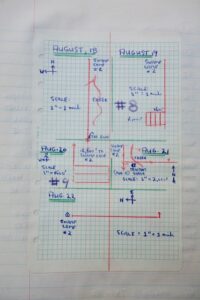
> > > August 20, 1958 > > Twelve hour trips on our blazed trails are not easy. No one, and I mean no one, will ever understand how hard this job has become. > We thought Robert’s injury yesterday would heal but today he sliced himself again…right to the bone. He had never handled an axe before > and chose to ignore instructions and kept swinging at twigs and light branches. His axe bounced back of course and this second time > cut himself damn close to an artery. Looks like some tendons may be severed. Surely not. We washed the blood from the wound and then applied another > tourniquet made from strips of my shirt…picked the cleanest parts we could rip. > > By evening his hand had swollen up and he was in severe pain. Gave him some sulpha hoping that would help him sleep. Nothing we could > do until dawn and then we must make fast tracks back to the river and motor down to our Base camp where we could radio for an emergency > flight to get Robert out to hospital. Getting out of this camp will take all day. No hope for an emergency flight until tomorrow. > Infection is a big worry. > > Distance covered 29,500 feet…very difficult terrain peppered with tag alder and windfalls. > 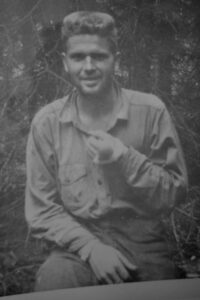
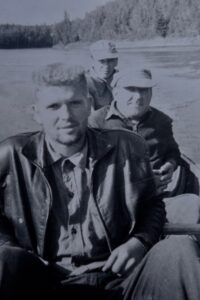
> > Robert Hopkins was hired to replace Floyd but just did not work out. He cut himself badly twice when his blazing axe bounced off some light branches > of tag alder. He was warned not to hit light branches but to aim his cuts at places where branches joined the main trunk. Getting him out was a > real exercise for us…Took 2.5 days and by then infection had set in. Looked like tendons were cut as well. Our tourniquet stopped the bleeding but > we could do little to arrest infection. > > > August 21, 1958 > > Robert’s hand is now discoloured which is a sure sign of infection. First Aid kit is little use at this point. We must get him out. > So began the long hike to our canoe at the river and then motoring five miles upstream to our base camp where we sent an SOS > call. Plane arrived and Robert Hopkins was no longer part of our crew. All of us a little depressed.
END PART 5 AUGUST 21,1958 WORST JOB I EVER HAD
EPISODE 6 BEGINS AUGUST 22, 1958 WORST JOB I EVER HAD
alan skeoch March 17, 2022
